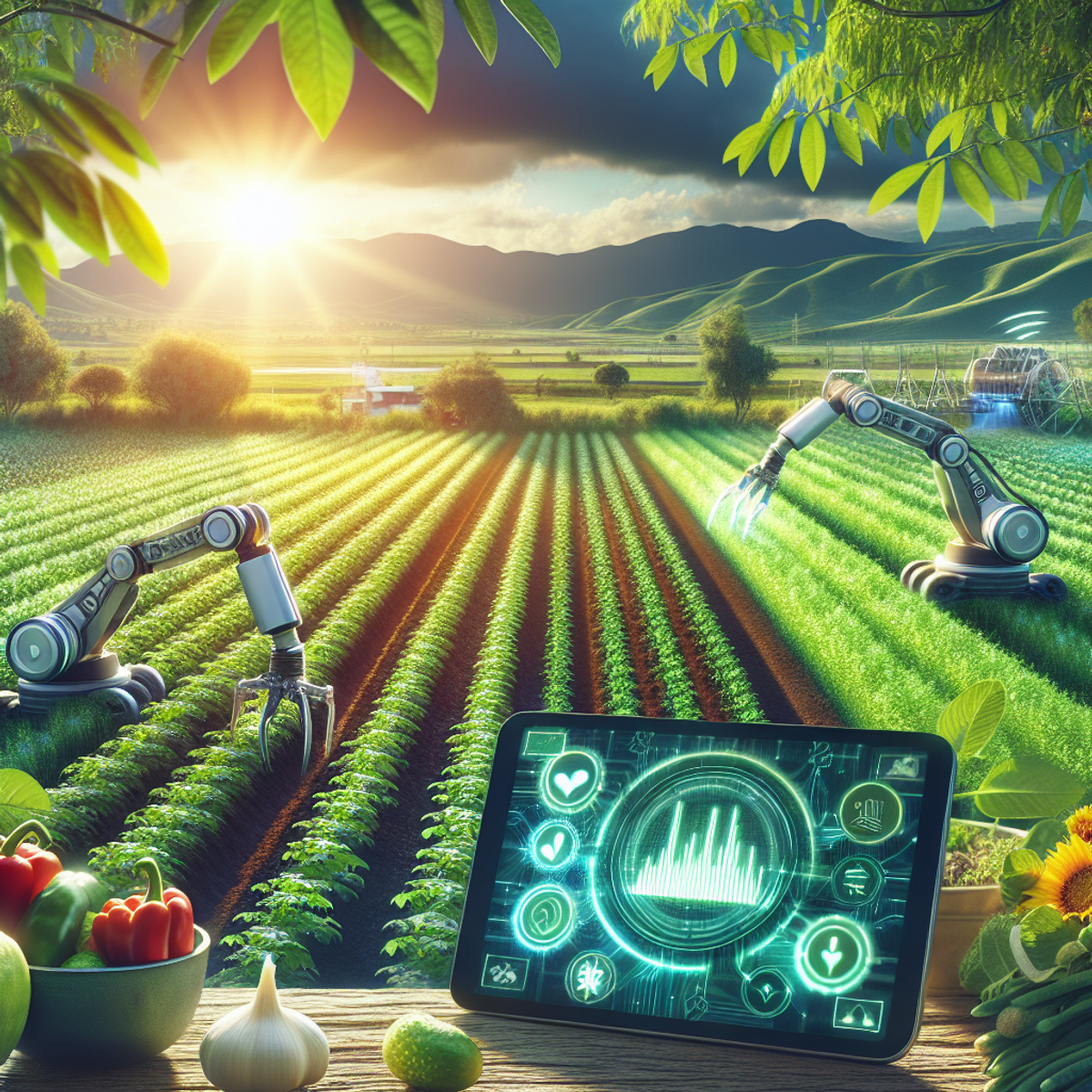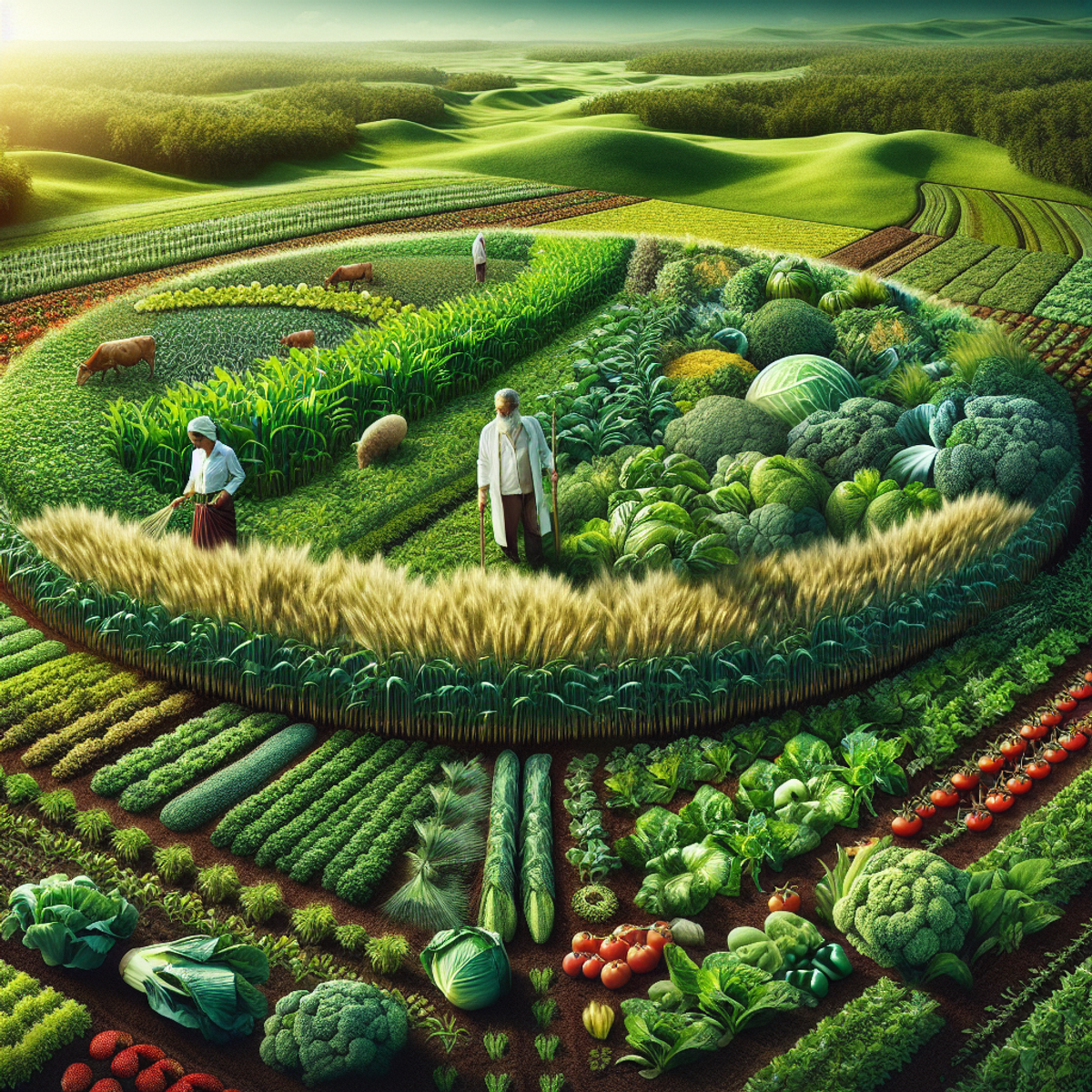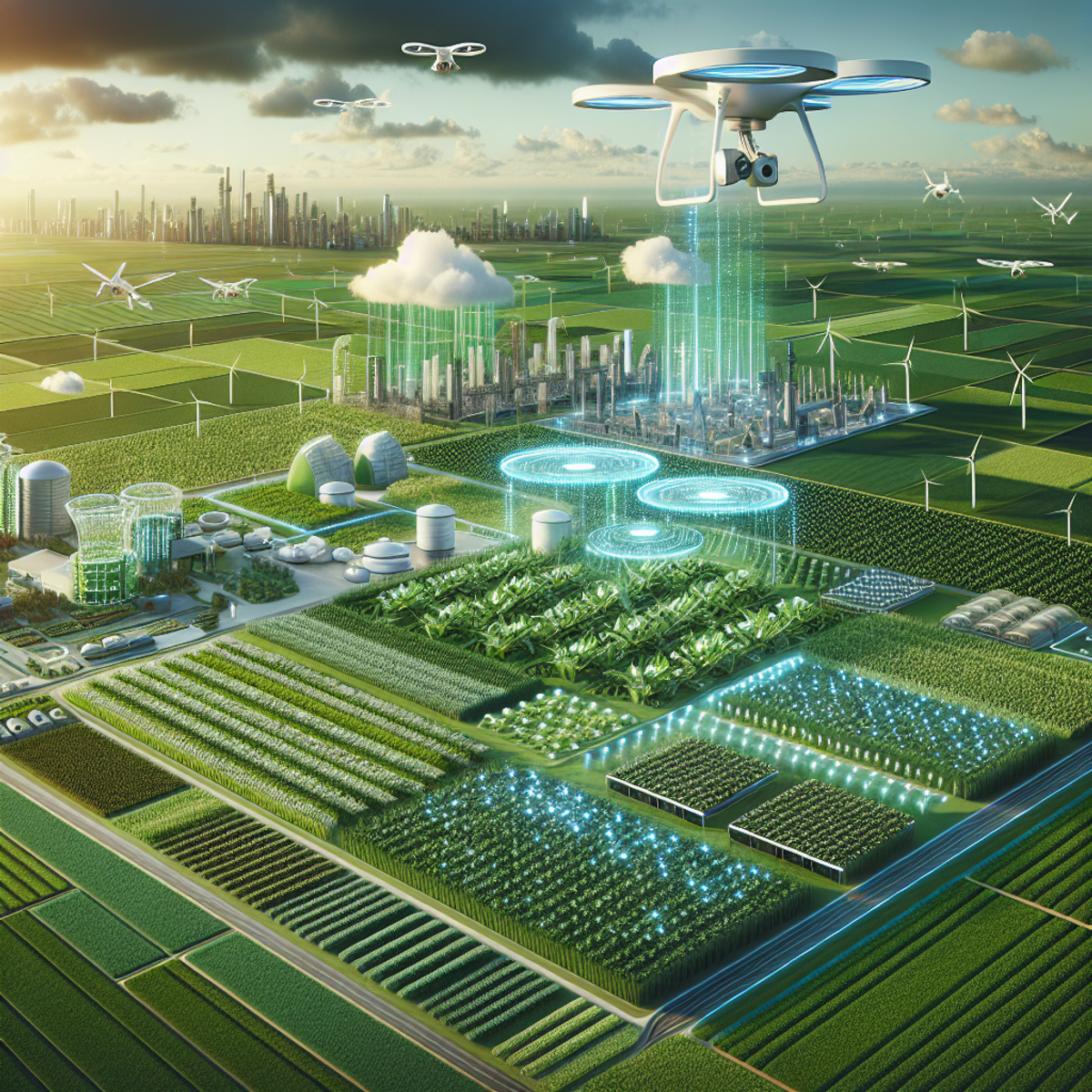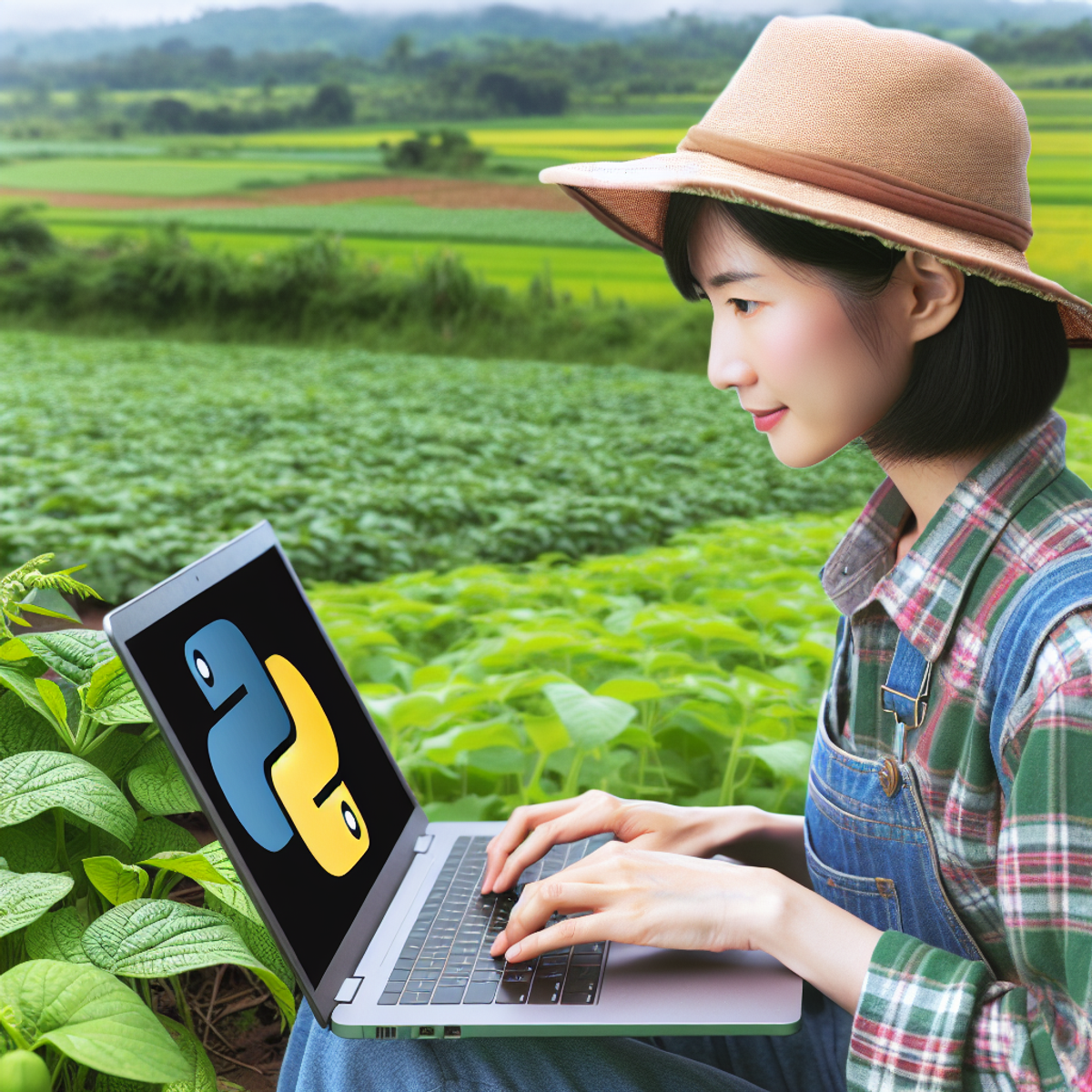Python for Sustainable Agriculture: Agroecology

Python for Sustainable Agriculture: Agroecology
Introduction
Sustainable agriculture is essential for long-term food security and environmental protection. With increasing pressures on agricultural systems, it's crucial to adopt sustainable practices. Technology, like Python programming language, has become a powerful tool in promoting sustainability in agriculture.
Agroecology is gaining recognition as an effective strategy for sustainable agriculture. It's a holistic farming approach that aligns with sustainability and ecosystem health principles. In this article, we'll explore how Python supports agroecological practices and empowers farmers and researchers in sustainable agriculture.
Sustainable Agriculture: Ensuring Food Security and Environmental Stewardship
Sustainable agriculture involves growing food and fiber while minimizing harm to the environment, supporting economic viability, and promoting social equity. The goal is to protect natural resources, use them efficiently, and maintain or improve ecosystem health.
By practicing sustainable agriculture, farmers can:
- Reduce soil erosion
- Conserve water resources
- Minimize chemical usage
- Preserve biodiversity
- Enhance climate resilience
These practices not only benefit the environment but also secure long-term food availability by maintaining soil fertility and productivity.
The Role of Technology in Advancing Sustainable Practices
Technology has transformed various areas of our lives, including agriculture. There's been a growing focus on using technology to address agricultural challenges. Innovations such as precision farming and remote sensing enable data-driven decision-making and optimal resource utilization.
Python, a versatile programming language known for its simplicity and readability, has gained popularity in agriculture due to its flexibility and extensive libraries. Farmers can leverage Python to automate tasks like data collection and analysis, develop decision support systems, and implement farm automation.
Exploring Agroecology: A Holistic Approach to Farming
Agroecology takes a holistic approach to farming by considering the interconnectedness of ecological, economic, and social factors in agricultural systems. It promotes the integration of ecological principles into farming practices to create sustainable and resilient systems.
Key practices of agroecology include:
- Enhancing biodiversity
- Facilitating nutrient cycling
- Minimizing external inputs
- Encouraging natural pest control
- Building healthy soil ecosystems
By adopting agroecology, farmers can reduce reliance on synthetic inputs, improve ecosystem services, and enhance the resilience of their farms.
In the next section, we'll explore agroecology in detail, including its principles and practices. Discover how Python can assist farmers in implementing agroecological approaches and driving sustainable agriculture.
What is Agroecology?
Agroecology is a holistic approach to agriculture that focuses on the ecological and social aspects of farming systems. It aims to optimize interactions between plants, animals, humans, and the environment while ensuring the long-term sustainability of agricultural production. This approach combines knowledge from ecology, agronomy, and social sciences to create farming systems that are both resilient and productive.
Principles of Agroecology
Agroecology follows several key principles that guide its sustainable agriculture practices:
- Biodiversity: Promoting a wide variety of crops and species, as well as encouraging beneficial relationships between different organisms within farming systems.
- Resource Cycling: Using resources efficiently by recycling organic matter, nutrients, and energy within the farm.
- Synergies and Symbiosis: Fostering mutually beneficial connections between different parts of the farm, such as using nitrogen-fixing plants or natural pest predators.
- Resilience: Designing farming systems that can adapt to changes in the environment, reduce dependence on external inputs, and withstand disruptions.
- Social Equity: Addressing issues of resource access, labor conditions, and community involvement in decision-making processes related to agriculture.
- Participatory Research and Knowledge Sharing: Including farmers in the creation of knowledge and innovation to develop solutions that are specific to their contexts.
Agroecological Practices
Agroecology includes various farming techniques that align with its principles:
- Agroforestry: Planting trees alongside crops to increase biodiversity, improve soil fertility, and provide additional products like fruits or timber.
- Polyculture: Growing multiple crops together in one field to imitate natural ecosystems and encourage positive interactions among plants.
- Crop Rotation: Changing the types of crops grown in specific fields over time to manage pests, diseases, and maintain soil fertility.
- Biological Pest Control: Utilizing natural enemies of pests, such as predatory insects or parasitic wasps, to control pest populations without synthetic pesticides.
- Composting and Organic Fertilization: Transforming organic waste into nutrient-rich compost for soil improvement instead of relying solely on chemical fertilizers.
Agroecology and Food Security
Agroecological practices have the potential to improve food security by promoting sustainable production systems. Through the use of diverse crop varieties, soil enrichment methods, and reduced reliance on external resources, agroecology can contribute to resilient food systems that can adapt to changing environmental conditions.
Aside from its environmental benefits, agroecology also addresses social aspects of food security by empowering local communities, preserving traditional knowledge, and ensuring fair access to resources.
Overall, agroecology represents a new way of thinking about agriculture that is more sustainable and adaptable. It offers solutions to complex issues surrounding food production, environmental preservation, and social fairness.
Sustainable Agriculture
Sustainable agriculture is an integrated farming approach that aims to meet the current needs for food and fiber while preserving the ecological balance of natural resources for future generations. This practice focuses on maximizing resource efficiency, minimizing environmental impact, and promoting economic viability for farmers. It encompasses a range of techniques and methods that contribute to long-term agricultural productivity and resilience.
Principles of Sustainable Agriculture
- Conservation of Natural Resources: Sustainable agriculture strives to conserve water, soil, and air quality by minimizing pollution, erosion, and depletion of natural resources.
- Biodiversity Preservation: It emphasizes the preservation of diverse plant and animal species to maintain ecological balance and promote natural pest control.
- Enhanced Soil Health: Sustainable agriculture practices prioritize building and maintaining healthy soils through organic matter additions, crop rotation, and reduced tillage.
- Economic Viability: The economic sustainability of farming operations is a key principle, ensuring that farmers can maintain profitability while adopting sustainable practices.
- Social Responsibility: It includes ethical considerations such as fair labor practices, community engagement, and equitable access to resources for all stakeholders involved in agricultural activities.
Techniques in Sustainable Agriculture
- Crop Rotation: By rotating crops on a seasonal basis, sustainable agriculture improves soil fertility, reduces pest pressure, and minimizes disease outbreaks.
- Agroforestry: Integrating trees into agricultural landscapes not only enhances biodiversity but also provides additional income sources for farmers through timber and fruit production.
- Integrated Pest Management (IPM): IPM strategies focus on preventing pest damage using biological controls, cultural practices, and targeted use of pesticides as a last resort.
- Precision Agriculture: Utilizing technology such as GPS-guided machinery and remote sensing to optimize inputs like water, fertilizer, and pesticides based on real-time crop needs.
Importance of Sustainable Agriculture
Sustainable agriculture plays a crucial role in addressing various global challenges:
- Environmental Conservation: By promoting environmentally friendly practices, sustainable agriculture contributes to mitigating climate change, protecting wildlife habitats, and conserving natural ecosystems.
- Food Security: It ensures consistent food production while preserving the capacity of future generations to meet their own food needs by avoiding overexploitation of resources.
- Economic Stability: Sustainable farming practices help farmers adapt to changing environmental conditions while maintaining or improving their livelihoods in the long run.
Policy Support for Sustainable Agriculture
Governments around the world are increasingly recognizing the importance of sustainable agriculture by implementing policies that incentivize and support its adoption. These policies may include:
- Subsidies for adopting sustainable practices
- Research funding for agroecological studies
- Regulatory frameworks that promote environmentally friendly farming techniques
Python for Sustainable Agriculture
Sustainable agriculture is evolving, and technology is playing a crucial part in shaping its future. Python, an adaptable and powerful programming language, is proving to be an invaluable tool in driving sustainable practices within the farming industry. Let's explore how Python can revolutionize sustainable agriculture.
Automating Agricultural Tasks with Python
1. Data Collection and Analysis
Python makes it possible to automate essential tasks like irrigation scheduling, pest monitoring, and crop rotation planning. By using Python's features, farmers can streamline the process of gathering and analyzing data. This, in turn, enables them to make well-informed decisions regarding resource management and ecological equilibrium.
2. Real-life Examples
There are numerous instances where Python-based farm automation systems have shown their effectiveness. These systems not only improve operational efficiency but also help reduce resource wastage while increasing productivity.
Intelligent Systems for Informed Decision-Making
1. Decision Support Systems
Python empowers the creation of intelligent decision support systems customized for agricultural purposes. These systems utilize algorithms written in Python to provide farmers with valuable insights. As a result, they can optimize yield stability and develop effective pest management strategies.
Overcoming Challenges with Python Adoption
- Technical Skills and Infrastructure: Farmers and researchers may face obstacles such as limited technical skills or access to technology infrastructure when implementing Python tools in agroecology. Addressing these challenges requires focused efforts towards capacity building and knowledge sharing initiatives.
- Capacity Building Initiatives: Highlighting the significance of training programs and collaborative networks becomes crucial in supporting farmers to effectively adopt Python-based solutions.
The Promising Future of Python in Agriculture
1. Leveraging Big Data and AI
The direction of agricultural technology is shifting towards utilizing big data and artificial intelligence (AI) for agroecological innovation. Python's extensive range of tools, including those used in machine learning techniques, is well-positioned to play a key role in driving sustainable practices on a larger scale through advanced data analytics and machine learning techniques.
In summary, it is clear that Python holds immense potential as a catalyst for transformative change in sustainable agriculture. Its ability to automate tasks, facilitate informed decision-making, and overcome adoption challenges makes it an essential component in empowering sustainable farming methods. The future looks promising for Python's integration into agroecology, marking a new era of technological innovation intertwined with ecological stewardship.
The Role of Python in Advancing Agroecology
Python is a versatile programming language that has found its way into various industries and fields, including agriculture. In recent years, it has gained popularity among researchers, farmers, and agroecologists due to its ability to handle complex data analysis tasks, automate farm management processes, and develop intelligent systems for decision-making.
Data Collection and Analysis in Agroecological Research
One of the key areas where Python shines is in data collection and analysis for agroecological research. Here's how it can be used:
- Gathering data on soil quality, biodiversity, and other important indicators in agroecosystems: Python can be employed to create automated data collection systems using sensors and IoT devices. These systems can collect data on various parameters such as soil moisture levels, temperature, humidity, and plant growth metrics.
- Gaining insights for decision-making in agroecological farming practices: Once the data is collected, Python libraries like NumPy, Pandas, and Matplotlib can be utilized to analyze and visualize the information. This analysis helps researchers and farmers understand patterns, identify trends, and make informed decisions about their farming practices.
Farm Management and Optimization through Automation
Another area where Python proves valuable is in farm management and optimization through automation. Here are some examples:
- Automating irrigation scheduling: By integrating weather forecast data with soil moisture sensor readings, farmers can use Python programs to automatically control irrigation systems. This ensures that crops receive the right amount of water at the right time, leading to water conservation and improved plant health.
- Monitoring pests using computer vision: Python's image processing capabilities can be leveraged to develop pest monitoring systems that analyze images from cameras placed in the fields. These systems can detect signs of pest infestation early on, allowing farmers to take prompt action.
- Planning crop rotations for nutrient management: Python algorithms can assist farmers in creating optimized crop rotation plans based on factors such as nutrient requirements, pest cycles, and market demand. This helps in maintaining soil fertility, reducing pest pressure, and diversifying farm income.
Supporting Farmer Decision-Making with Intelligent Systems
Python can also be used to build intelligent systems that support decision-making processes for farmers. Here's how:
- Understanding decision support systems: Decision support systems are software tools that provide farmers with data-driven recommendations and insights to aid their decision-making. These systems take into account various factors like weather conditions, market prices, and crop performance data.
- Developing decision support systems using Python algorithms: Python's extensive library ecosystem, including scikit-learn and TensorFlow, makes it easier to develop machine learning models and algorithms for decision support systems. These models can analyze historical data, predict future outcomes, and suggest optimal actions for farmers.
- Optimizing yield stability and pest management strategies: By implementing decision support systems powered by Python, farmers can potentially achieve higher yield stability by adapting their farming practices to changing conditions. They can also improve pest management strategies by receiving timely alerts about potential outbreaks and recommended control measures.
Overall, Python offers a wide range of tools and capabilities that can greatly benefit the field of agroecology. From data analysis to automation and intelligent systems, this programming language has the potential to drive sustainable agriculture practices forward.
Challenges and Limitations in Applying Python for Agroecological Purposes
Addressing Potential Barriers
Farmers and researchers may face challenges in utilizing Python tools in agroecology due to limited technical skills or access to technology infrastructure.
Need for Capacity Building and Knowledge Sharing Initiatives
- Emphasizing the importance of training programs and collaborative networks to support farmers in effectively adopting Python-based solutions is crucial.
- Existing initiatives that facilitate knowledge exchange between agricultural and tech communities should be highlighted.
The integration of Python in agroecology presents several challenges and limitations that need to be addressed for widespread adoption and impact. It's essential to acknowledge the potential barriers faced by farmers and researchers when utilizing Python tools in agroecology.
One significant obstacle is the limited technical skills among farming communities, especially in regions where access to formal education or advanced training is restricted. Additionally, the availability of technology infrastructure, such as access to computers and reliable internet connectivity, can pose significant challenges for those looking to leverage Python for sustainable agriculture practices.
To overcome these barriers, there is a critical need for capacity building initiatives that focus on enhancing the technical proficiency of individuals involved in agroecological research and farming. Training programs tailored to the specific needs of agricultural communities can play a pivotal role in equipping farmers with the necessary programming skills to effectively utilize Python for tasks such as data analysis, automation, and decision support systems.
Furthermore, collaborative networks that bring together experts from both the agricultural and technology sectors are essential for fostering knowledge sharing and skill development. By creating platforms for cross-disciplinary interactions, existing initiatives can facilitate the exchange of best practices, successful case studies, and practical insights regarding the application of Python in agroecology.
Highlighting the significance of these capacity building and knowledge sharing initiatives is fundamental for addressing the challenges associated with integrating Python into sustainable agricultural practices. By emphasizing the importance of accessible training programs and collaborative networks, stakeholders can work towards overcoming barriers and promoting the widespread adoption of Python-based solutions in agroecology.
The Future of Python in Empowering Sustainable Agriculture
As technology continues to advance, the role of Python in sustainable agriculture is expected to grow significantly. With its versatility and wide range of applications, Python has the potential to revolutionize the agricultural industry and empower farmers to adopt more sustainable practices. Here are some key trends and opportunities for Python in the context of sustainable agriculture:
Leveraging Big Data and Artificial Intelligence for Agroecological Innovation
One of the most promising areas where Python can make a significant impact is in leveraging big data and artificial intelligence (AI) for agroecological innovation. With the increasing availability of data from various sources such as weather stations, soil sensors, satellite imagery, and farm machinery, there is a wealth of information that can be used to optimize farming practices.
Python's powerful data analysis libraries, such as Pandas and NumPy, combined with machine learning frameworks like scikit-learn and TensorFlow, enable farmers to analyze large datasets and make data-driven decisions. For example:
- By analyzing historical weather data and crop yields, farmers can use Python algorithms to predict optimal planting times and optimize irrigation scheduling.
- Machine learning models developed using Python can help identify patterns in pest outbreaks or disease spread, allowing farmers to implement targeted interventions rather than widespread pesticide application.
- Python-based image recognition algorithms can analyze satellite imagery or drone footage to monitor crop health and detect nutrient deficiencies or pest infestations.
Ongoing research projects and startup developments further highlight the potential of Python in agroecological innovation. For instance:
- The PlantVillage project at Penn State University utilizes Python to develop a smartphone app that uses AI algorithms to diagnose plant diseases based on images uploaded by farmers. This technology allows for early detection and effective treatment, reducing crop losses and pesticide use.
- The OpenAg Initiative by MIT Media Lab explores the use of AI-controlled indoor farming systems powered by Python programming. These systems optimize growing conditions, reduce water and nutrient waste, and maximize crop yield.
Exploring Opportunities with Python in Sustainable Agriculture
For farmers, researchers, and tech enthusiasts interested in exploring the opportunities that Python offers in sustainable agriculture, there are numerous resources available. Here are a few suggestions:
- Books: "Python for Data Analysis" by Wes McKinney provides a comprehensive guide to data analysis using Python, while "Machine Learning for Agriculture" by Emmanuel Ameisen explores machine learning techniques specifically applied to agriculture.
- Online Courses: Platforms like Coursera and edX offer online courses on data science and machine learning with Python. Courses such as "Applied Data Science with Python" and "Machine Learning for Agriculture" can provide a solid foundation for those looking to apply Python in agroecology.
- Open-source Projects: Many open-source projects related to sustainable agriculture are developed using Python. Exploring platforms like GitHub can help users discover projects they can contribute to or learn from.
- Community Forums: Online communities like Stack Overflow and Reddit have dedicated sections for Python programming in agriculture or data science. Engaging with these communities can provide valuable insights, guidance, and collaboration opportunities.
By embracing Python's capabilities and staying up-to-date with emerging trends, farmers and researchers can unlock the potential of sustainable agriculture. With the ability to
Conclusion
Sustainable agriculture is not just a concept but a necessity in today's world. The integration of technology, particularly Python, has opened new avenues for advancing agroecology and promoting sustainable farming practices. Throughout this article, we have explored the various ways Python contributes to sustainable agriculture:
Recap of Key Points:
- Python's Versatility: We have seen how Python serves as a versatile programming language that can be utilized for various agricultural applications, from data collection and analysis to developing intelligent decision support systems.
- Real-Life Examples: Real-life examples of farm automation systems powered by Python highlight its practical implementation in agroecological settings.
- Challenges and Solutions: While there are challenges in utilizing Python tools in agroecology, initiatives for capacity building and knowledge sharing are crucial in overcoming these barriers.
- The Future Outlook: The future of Python in sustainable agriculture looks promising, with the potential for leveraging big data and artificial intelligence to drive agroecological innovation.
As we move forward, it is essential for farmers, researchers, and tech enthusiasts to recognize the opportunities that Python offers in the context of sustainable agriculture. By embracing this technology, they can contribute to building resilient and productive food systems while addressing global challenges such as poverty, hunger, and climate action.
I encourage you to explore the diverse applications of Python in agroecology further. Whether you are a farmer looking to optimize your agricultural practices, a researcher delving into sustainable solutions, or a tech enthusiast interested in agricultural innovation, Python holds immense potential for driving positive change.
For those eager to deepen their understanding of Python's applications in agroecology, consider exploring resources such as books, online courses, and research papers that delve into this intersection. By staying informed and engaged with the latest developments in agricultural technology powered by Python, we can collectively contribute to a more sustainable future for agriculture.
In conclusion, the journey towards sustainable agriculture is ongoing, and Python stands as a valuable ally in this pursuit. By leveraging its capabilities and fostering collaboration between agricultural and tech communities, we can strive towards a future where agroecology thrives hand-in-hand with technological innovation.
Together, let's embrace the potential of Python for sustainable agriculture and work towards nurturing our planet through ecologically sound farming practices.
FAQs (Frequently Asked Questions)
What is Agroecology?
Agroecology is a holistic approach to farming that aligns with the principles of sustainability and ecosystem health. It emphasizes the interdependence between plants, animals, humans, and the environment to create agricultural systems that are both productive and sustainable.
What is Sustainable Agriculture?
Sustainable agriculture refers to the practice of farming in a way that meets the needs of the present without compromising the ability of future generations to meet their own needs. It aims to maintain ecological balance, conserve natural resources, and promote biodiversity while ensuring economic viability for farmers.
What is Python for Sustainable Agriculture?
Python is a versatile programming language that plays a significant role in advancing sustainable practices in agriculture. It can be used for data collection and analysis in agroecological research, farm management and optimization through automation, and developing intelligent decision support systems for farmers.
What is the Role of Python in Advancing Agroecology?
Python's role in advancing agroecology is multifaceted. It enables data collection and analysis in agroecological research, supports farm management and optimization through automation, and facilitates the development of intelligent decision support systems for farmers.
What are the Challenges and Limitations in Applying Python for Agroecological Purposes?
Challenges in applying Python for agroecological purposes may include limited technical skills or access to technology infrastructure among farmers or researchers. Capacity building and knowledge sharing initiatives are important to support effective adoption of Python-based solutions in agriculture.
What is the Future of Python in Empowering Sustainable Agriculture?
The future of Python in empowering sustainable agriculture involves leveraging big data and artificial intelligence for agroecological innovation. Advanced data analytics and machine learning techniques enabled by Python ecosystems are expected to drive sustainable practices at a larger scale.



Comments
Post a Comment